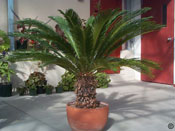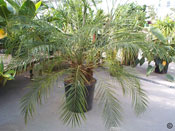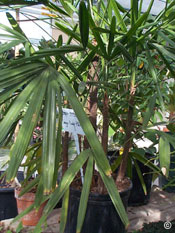
The palm family includes 2500 species. With very few exceptions, palms grow in the wild only in the tropics and subtropics. Although the perception of palms is of tall solitary trunks, many have several trunks and are low and shrubby. Some are tall vines with thin stems hundreds of feet long. Palms vary tremendously in outward appearance, uses and adaptability in cultivation.
 Palms can be used as landscape plants in warmer climates. They also grow successfully in greenhouses and as houseplants. In fact, they are an ideal subject for the indoor gardener. Some of the palms best suited as houseplants include queen palm, Alexandra plum, bottle palm, parlor palm, Mediterranean fan palm, Kentia palm, date palm and lady palm.
Palms can be used as landscape plants in warmer climates. They also grow successfully in greenhouses and as houseplants. In fact, they are an ideal subject for the indoor gardener. Some of the palms best suited as houseplants include queen palm, Alexandra plum, bottle palm, parlor palm, Mediterranean fan palm, Kentia palm, date palm and lady palm.

To grow effectively as a houseplant, most palms require increased humidity, bright indirect sunlight and thorough watering. Increase humidity within the house by placing plants on pebble trays or by placing a humidifier within the room. When watering, it is important to thoroughly soak the plant, making sure to empty the saucer an hour after watering. When repotting, always use a potting mix that drains well. Be careful not to put palms in too large of a container; use a pot not more than two sizes larger. When fertilizing, use a general-purpose fertilizer, follow label directions, and apply it throughout the growing season to help maintain healthy plants with good leaf color.



